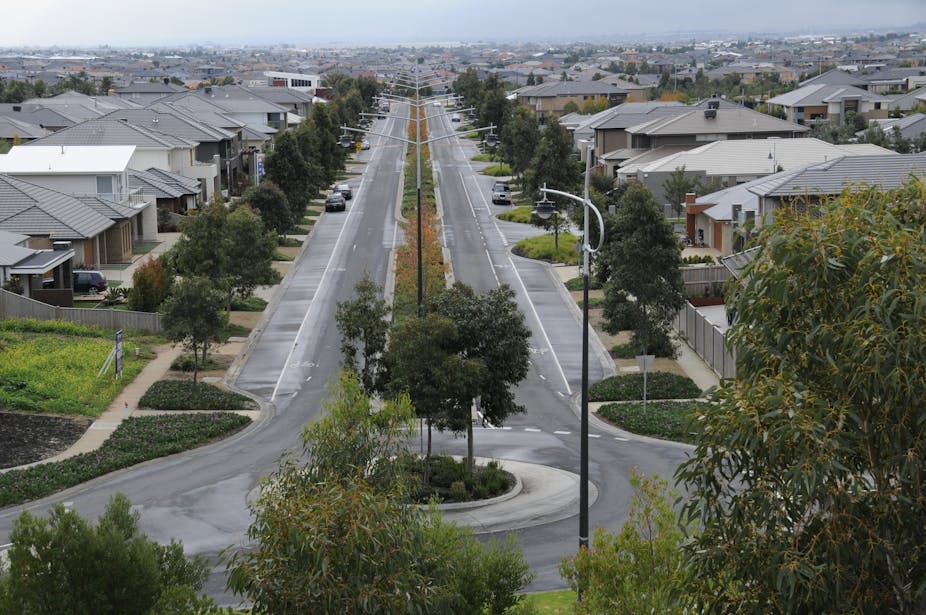Australian cities are growing fast – and fastest at the fringe. Streets, houses, parks and shops are appearing where recently all was paddocks and cows.
A new house is completed in an urban growth area every 15 minutes. These areas are home to more than three million Australians and their populations are growing more than twice as fast as the national average.
Yet these greenfield neighbourhoods won’t be new for long. Soon they will be a solid part of the urban fabric. The irony is that as the new suburbs become more established, they will also need to become more flexible, because we can expect that within a generation their demographic make-up will have shifted substantially.
As households mature, people move in and out, and communities evolve, the needs and preferences of residents change. Successful suburbs change as the community changes, delivering different housing options and new services as the need arises. If suburbs fail to do this, then they will become less desirable places to live. If they cannot attract new residents and new businesses, they won’t experience the renewal that is essential to a vital city.

It is understandable that policy makers and property developers are focused on catering to the immediate requirements of the initial residents of greenfield areas. Given the speed of growth this is a significant challenge. But there are also things we can do now to ensure that our newest suburbs thrive in the future. A new report from the Grattan Institute, Tomorrow’s suburbs: building flexible neighbourhoods, shows how it might happen.
In a flexible suburb land can be used for different activities over time, without restrictive covenants or onerous zoning rules preventing change. For example, a home-owner could establish a small business in the garage or build a granny flat in the backyard.
Flexible suburbs will also offer a range of housing options, enabling residents to stay in the same area but move into a different type of dwelling if their needs change. Some people might choose to live in a smaller home later in life, or they might have different housing needs if a relationship breaks up.
Flexible suburbs provide the space and opportunity to establish local enterprises. They also have the capacity to offer new services and recreational choices in line with changing needs. A playground designed for primary school children will hold few attractions for teenagers.
Suburbs that can adapt in these and other ways are more likely to remain desirable, high-quality places to live, holding existing residents and businesses and attracting newcomers and new investment.
We can see the value of flexibility in existing urban areas, especially the older core of our cities. In recent decades the return of residents to inner city areas has revived central business districts and nearby suburbs. By pure chance, certain characteristics of these older areas facilitated that process of urban renewal.

The interweaving of residential buildings and commercial premises into mixed-use neighbourhoods gave residents easy access to a range of shops and services. The presence of a diverse range of buildings, including former factories and warehouses, enabled the conversion of existing structures to new uses.
Strong public transport networks and proximity to jobs lifted land values and made redevelopment viable.
Many of the communities now being established in greenfield areas lack these qualities. Instead of mixed-use neighbourhoods, residential, commercial and other activities are largely kept separate. Town centres tend to lack a diversity of shops and businesses. Transport networks are often weak.
Housing is dominated by uniform lot sizes containing detached family-style dwellings. There is not much housing designed for people who might live alone, either by choice or because of a change in their life circumstances.
These features of greenfield suburbs have consequences for residents and for a city as a whole. If a suburb struggles to adapt to changing needs and preferences, it may struggle to regenerate by attracting a wide range of residents. In that case, development is more likely to continue to expand into new greenfield sites even further from the city centre. Congestion will grow, commuting journeys will lengthen and greater investment will be required for new infrastructure.
We need to make our new suburbs, shopping centres, buildings and homes more adaptable to change, without imposing undue burdens or costs on current residents.
Policy makers should look again at restrictive covenants and rezoning, with a view to making them more flexible. Streets around greenfield shopping centres might be used to allow a greater variety of local businesses to emerge over time. Above all, we must ensure that greenfield developments are flexible enough to become the successful suburbs of tomorrow.
More detail is available at “Tomorrow’s Suburbs: Building flexible neighbourhoods”.

